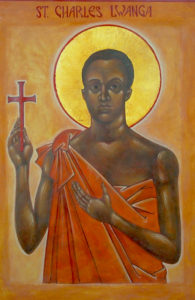
Today we continue our regular series called “Learning from the Saints.” Our guide is expert Bert Ghezzi, a dear friend of mine and the author of numerous books including Voices of the Saints, Saints at Heart, and Discover Christ: Developing a Personal Relationship with Jesus.
His more recent books are The Power of Daily Mass and The Heart of Catholicism. You can learn more about Bert and his work at BertGhezzi.com.
Today, Bert profiles St. Charles Lwanga, the patron of converts and torture victims whose feast we celebrate today.
 In the 1880s, missionaries introduced Christianity into the Ugandan kingdom of Buganda. Fearing for their power, witch doctors persuaded king Mwanga that the new religion would undermine his authority.
In the 1880s, missionaries introduced Christianity into the Ugandan kingdom of Buganda. Fearing for their power, witch doctors persuaded king Mwanga that the new religion would undermine his authority.
The eighteen-year-old ruler was alcoholic and addicted to sexual relations with boys. In May, 1886, he tried to seduce a page and discovered that a young man was instructing him in the faith. Enraged, he drove a spear through the catechist’s neck. Then he demanded that all the Christian pages renounce their faith or face death. They chose death. So, on June 3, 1886, he had them executed at Namugongo, a place of ritual sacrifice.
Charles Lwanga, a young leader, who had protected the pages, was the first to be martyred. A page, who was pardoned, described his death:
“We set out walking in single file, a rope from neck to neck joining us. Every one of us prayed in his heart, but not aloud. When we arrived in the valley we were ordered to halt where the high executioner, Senkole, and a crowd waited.
“Senkole separated Charles from the others, saying: ‘This is the man of my choice. He’ll be my victim.
“Lwanga said to us: ‘Friends I am staying here. Good-bye! We shall meet again in heaven.’ With one voice we answered, ‘Yes, before the throne of God. Au revoir.’”
Charles was laid on a pyre under which the fire was kept low. The flame slowly charred his legs without touching the rest of his body. A witness remembered:
“Senkole said to Charles: ‘Let’s see whether Katonda (God )will come to deliver you from the fire.’
“Bearing his agony without a murmur, Charles said: ‘Poor, foolish man, you don’t know what you say. You are burning me, but it is as if you were pouring water on my body. I die because of the religion of Katonda. But you, you will see trouble. Katonda, whom you insult, will one day plunge you into real fire. Sir, if you only you would become a Christian.’”
Charles prayed quietly while the fire slowly did its work. Just before the end, he cried out, “Katonda wange!” (My God!) and died.
Then the other pages were stripped, wrapped in reed mats, piled on a huge pyre and burnt alive. “We have killed many people,” said one executioner, “but never such as these. Other victims did nothing but moan and weep. There was not a sigh, not even an angry word. All we heard was a soft murmur on their lips. They prayed until they died.” That day, thirteen Catholics, eleven Protestants and eight unbaptized seekers, ranging in age from 13 to 25, offered their lives in the flames.
“A well,” said one of the martyrs prophetically, “that has many sources never runs dry. When we are gone, others will come after us.” Already by 1890, the number of Christians in Buganda was estimated at 10,000.
Read more from Bert at his website www.BertGhezzi.com, or check out his many books on Amazon.
